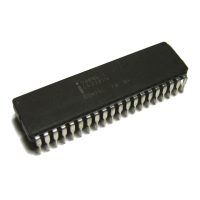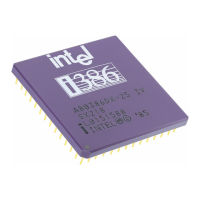INTRODUCTION TO THE
80286
1.2
MODES
OF
OPERATION
The 80286 can be operated in either of two different modes: Real Address Mode or Protected Virtual
Address Mode (also referred to as Protected Mode).
In
either mode of operation, the 80286 represents
an upwardly compatible addition
to
the 8086 family of processors.
In
Real Address Mode, the 80286 operates essentially
as
a very high-performance 8086. Programs
written for the 8086 or the 80186 can be executed in this mode without any modification (the
few
exceptions are described in Appendix C, "Compatibility Considerations"). Such upward compatibility
extends even to the object code level; for example, an 8086 program stored in read-only memory
will
execute successfully in 80286 Real Address Mode. An 80286 operating in Real Address Mode provides
a number of instructions not found
on
the 8086. These additional instructions, also present with the
80186, allow for efficient subroutine linkage, parameter validation, index calculations, and block
1/0
transfers.
The advanced architectural features and full capabilities of the 80286 are realized in its native Protected
Mode. Among these features are sophisticated mechanisms to support data protection, system integ-
rity, task concurrency, and memory management, including virtual storage. Nevertheless, even in
Protected Mode, the 80286 remains upwardly compatible with most 8086 and 80186 application
programs. Most 8086 applications programs can be re-compiled or re-assembled and executed
on
the
80286 in Protected Mode.
1.3
ADVANCED FEATURES
The architectural features described in section
1.1
of this chaper are common to both operating modes
of the processor.
In
addition to these common features, Protected Mode provides a number of advanced
features, including a greatly extended physical and logical address space,
new
instructions, and support
for additional hardware-recognized data structures. The Protected Mode 80286 includes a sophisti-
cated memory management and multilevel protection mechanism. Full hardware support
is
included
for multitasking and task switching operations.
1.3.1 Memory Management
The memory architecture of the Protected Mode 80286 represents a significant advance over that of
the 8086. The physical address space has been increased froml megabyte
to
16
megabytes (2
24
byies),
while the virtual address space (i.e., the address space visible to a program) has been increased from
1 megabyte to 1 gigabyte
(2
30
bytes). Moreover, separate virtual address spaces are provided for each
task in a multi-tasking system (see the next section, 1.3.2, "Task Management").
The 80286 supports on-chip memory management instead of relying
on
an external memory manage-
ment unit. The one-chip solution
is
preferable because
no
software
is
required to manage an external
memory management unit, performance
is
much better, and hardware designs are significantly simpler.
Mechanisms have been included in the 80286 architecture to allow the efficient implementation of
virtual memory systems. (In virtual memory systems, the user regards the combination of main and
external storage
as
a single large memory. The user can write large programs without worrying about
the physical memory limitations of the system. To accomplish this, the operating system places some
of the user programs and data in external storage and brings them into main memory only
as
they are
needed.) All instructions that can cause a segment-riot-present fault are fully restart able. Thus, a not-
present segment
can
be loaded from external storage, and the task can be restarted at the point where
the fault occurred.
1-2

